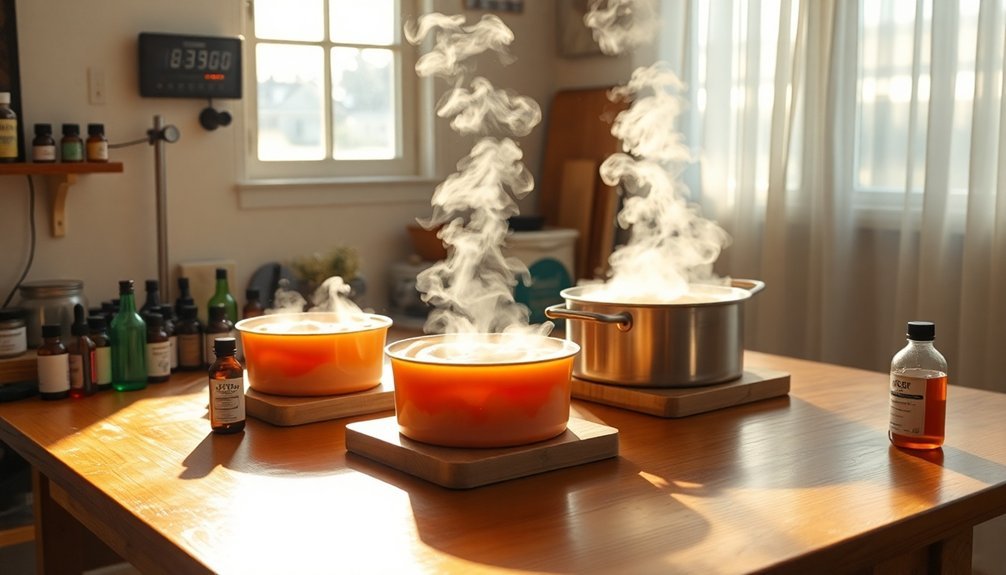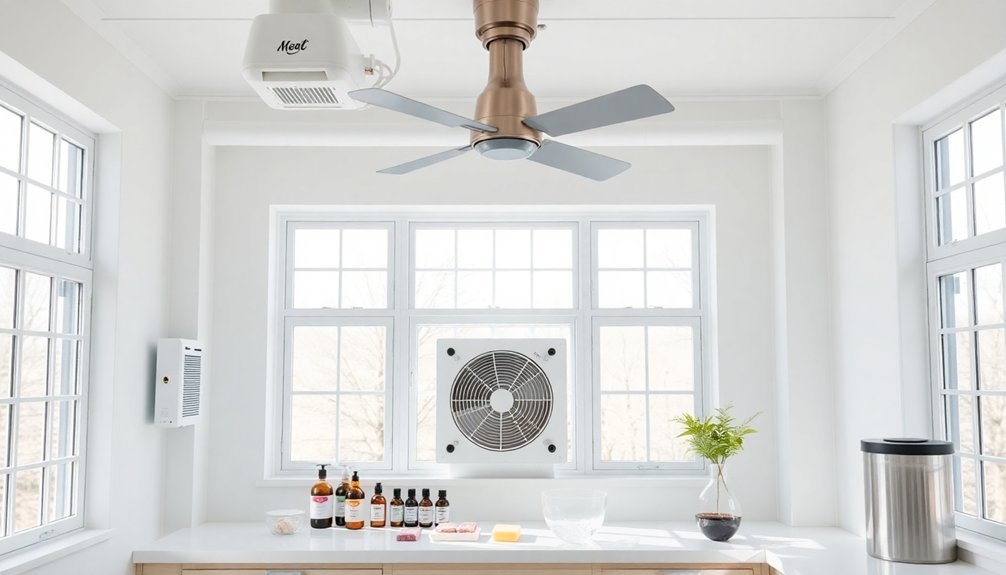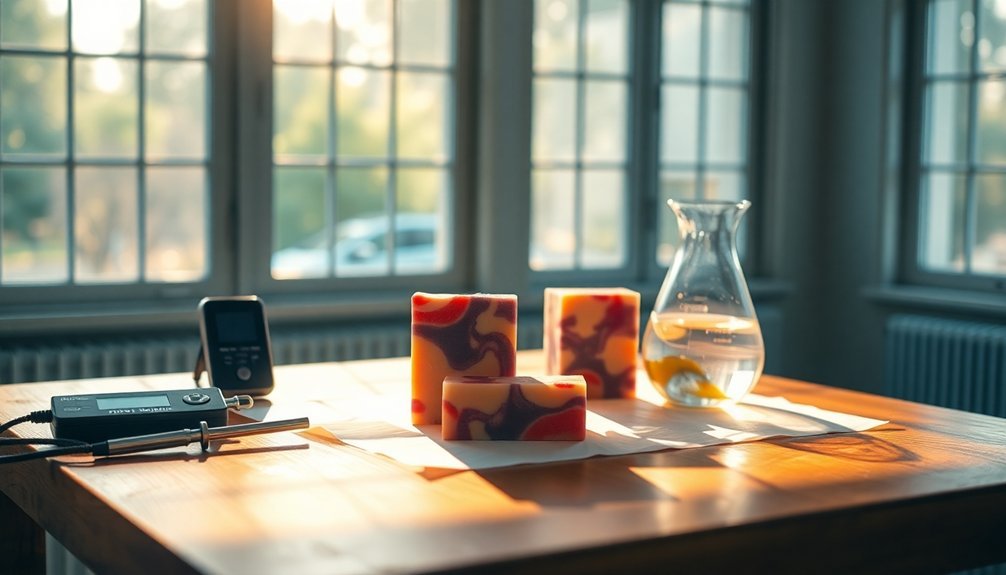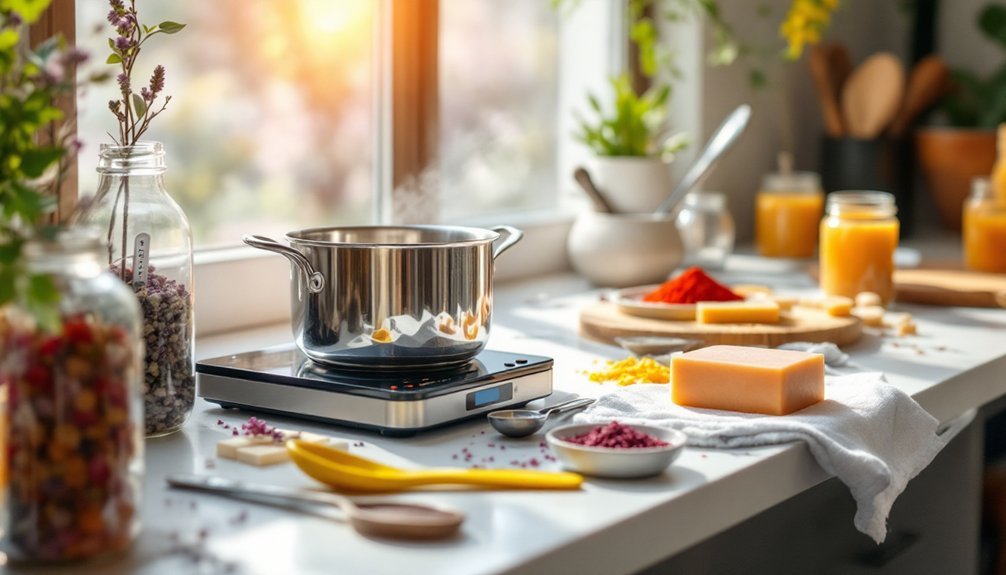For hot process soap making, you'll need a room temperature between 70-75°F and humidity of 40-50%. Install proper ventilation with fans near windows to disperse lye fumes. Use bright, neutral lighting (around 5000K) for accurate color assessment. Organize your workspace into distinct zones for preparation, mixing, molding, and curing. Maintain good air circulation without direct airflow on soaps. Keep a clean, uncluttered space with easy access to safety equipment. These ideal conditions will transform your soap-making results.
7 Perfect Room Conditions For Hot Process Soap

While making hot process soap requires attention to ingredients and technique, the environment in which you work plays a crucial role in your success. Your soap-making space should be well-ventilated to prevent inhaling lye fumes, which can be harmful if concentrated.
Maintain a stable room temperature to guarantee consistent results in your soap batches. This helps prevent unexpected reactions during the saponification process. Ideally, you should preheat your oven to 170 degrees Fahrenheit when preparing for the HPOP method.
You'll want to organize your workspace efficiently, keeping all ingredients and tools easily accessible but safely arranged to avoid accidents.
Temperature monitoring isn't just for your soap mixture—the ambient room conditions affect how your soap cures. Low humidity environments are ideal for the curing phase, helping your soap harden properly.
Optimal Temperature Range for Soap Workrooms
You'll find that maintaining a consistent room temperature between 70-75°F provides the perfect environment for hot process soap making.
Your workspace temperature stability directly impacts the predictability of your soap's behavior during cooking phases.
Unlike cold process soap making which requires oils and lye temperatures around 120-130°F, hot process soap benefits from stable ambient conditions to prevent temperature-related issues like overheating that can lead to soap volcanoes or alien brain formation.
As seasons change, you'll need to adjust your heating or cooling systems accordingly to maintain these ideal conditions for consistent results.
Temperature Stability Matters
Although precise ingredient temperatures are critical in soapmaking, the ambient conditions of your workroom also play a significant role in the success of hot process soap.
While hot process is more forgiving than cold process regarding room temperature, stability matters. Your workroom doesn't need to match the 165°F-200°F saponification range, but extreme temperatures can interfere with your process. A moderate room temperature (65°F-75°F) helps maintain consistent results without fighting your equipment.
Cold drafts can prematurely cool your mixture, while excessive heat might accelerate reactions unpredictably. Unlike cold process soap, which requires careful temperature management to prevent false trace, hot process relies more on your heat source for consistency.
Still, you'll want to avoid dramatic temperature fluctuations that could affect additives and final soap quality. Working in a distraction-free environment is essential for safely managing the caustic substances and precise measurements required for successful hot process soap making.
Seasonal Adjustments Needed
Seasons bring unique challenges to hot process soap making, requiring thoughtful adjustments to your workroom environment.
Winter demands special attention as cold temperatures can disrupt your soap's chemical reactions. Verify your heating system maintains a stable temperature throughout your workspace. Aim to keep your workroom within the 90°F to 110°F range for optimal soap making results.
You'll need to monitor air dryness during winter months, as it can accelerate soap hardening. Consider adding a humidifier to maintain ideal moisture levels.
Conversely, summer's high humidity might require dehumidifiers to prevent excessive soap sweating.
Year-round, proper ventilation remains critical for dispersing lye fumes. Install fans or ventilation systems that work effectively regardless of outdoor conditions.
Always adapt your process to the season—opt for room temperature methods during extreme weather to minimize temperature fluctuations that could compromise your finished product's quality.
Essential Ventilation Setup to Manage Lye Fumes

Proper ventilation stands as the cornerstone of safe hot process soap making, particularly when working with lye. Without adequate airflow, dangerous fumes can accumulate, causing respiratory irritation or worse.
Never compromise on ventilation when making soap—lye fumes can silently harm your respiratory system without proper airflow.
You'll need to establish a ventilation system that consistently moves air through your workspace.
- Primary ventilation options: Install fans near windows to create cross-ventilation, or use your kitchen's oven ventilation system when mixing lye and during the cooking process.
- Protective measures: Keep respirators on hand for times when ventilation alone isn't sufficient, especially when measuring and mixing lye with water. Consider turning on additional fans to improve air circulation when working indoors.
- Space considerations: Work outdoors when weather permits, or create a dedicated indoor space with multiple ventilation points and clear pathways for air to circulate effectively.
Proper Humidity Levels for Consistent Soap Quality
How exactly does humidity affect your hot process soap? Your soap constantly seeks moisture equilibrium with its environment. In high humidity, soap absorbs water; in dry conditions, it releases moisture faster. This directly impacts curing time and final quality.
For ideal results, maintain relative humidity between 40-50% in your soaping area. While hot process soap requires less curing time than cold process, proper humidity still matters. The standard cure time for hot process soaps is generally about 3-4 weeks, shorter than cold process alternatives.
Too humid (above 80%), and your soap may "sweat" due to glycerin attracting moisture. Too dry (below 20%), and it might become brittle.
Consider using a dehumidifier in damp environments or adding minimal water to your recipe when working in arid conditions.
Remember that consistent humidity, combined with good ventilation, guarantees your hot process soap cures properly.
Ideal Lighting Configuration for Process Monitoring

Lighting your workspace correctly can make the difference between successful soap batches and frustrating mistakes. When monitoring hot process soap, you'll need bright, even lighting that accurately represents colors while minimizing shadows.
For ideal monitoring conditions:
- Position lights at corners of your workspace to reduce shadows and provide extensive visibility of separation stages and gel phases.
- Choose lighting with neutral color temperature (around 5000K) to accurately assess colorant distribution and detect any unwanted color shifts.
- Verify your lighting is adjustable in intensity to highlight textural changes during different soap-making stages without creating distracting glare.
Natural light works best for color representation, but supplement with artificial lighting when needed to maintain consistency regardless of weather conditions or time of day. Never step away from your workspace during the cooking process as this could result in a soap volcano that ruins your batch and creates a significant cleanup challenge.
Workspace Layout for Maximum Safety and Efficiency
Designing an efficient workspace for hot process soap making requires careful attention to both safety and workflow considerations. Position your work surface at a comfortable height to prevent strain during lengthy soap-making sessions.
Place your sink adjacent to your main workspace for quick access to water and easy cleanup of potentially hazardous materials.
Separate your area into distinct zones: ingredient preparation, mixing, molding, and curing. This streamlines your process and minimizes cross-contamination.
Install proper ventilation through windows, doors, or exhaust fans to remove harmful fumes. Choose stainless steel surfaces for their durability and ease of cleaning.
Keep your frequently used tools within arm's reach and store chemicals in appropriate glass or stainless steel containers. Incorporate labeled storage bins to organize your various soapmaking materials effectively.
Don't forget to designate space for your PPE and fire extinguisher for immediate access during emergencies.
Air Circulation Requirements During Curing Phases

After setting up your ideal workspace, you'll need to focus on the atmospheric conditions that affect your soap's curing process. Proper air circulation plays a crucial role in hot process soap curing; even though the saponification is complete, your soap still needs to release excess moisture.
While hot process soap completes saponification early, proper air circulation remains essential for releasing excess moisture during curing.
- Create consistent airflow – Position fans strategically to guarantee even ventilation without direct airflow hitting your soaps, which helps maintain uniform moisture evaporation. Since hot process soap requires specific unmolding techniques to avoid damage, good air circulation helps develop the right consistency for easier removal from molds.
- Monitor humidity levels – In humid environments, consider using a dehumidifier to keep levels ideal, preventing your soap from becoming too soft or extending curing time.
- Check temperature stability – Maintain temperatures between 72°F and 84°F to allow controlled evaporation without creating a premature skin on your soap bars.
Frequently Asked Questions
Can I Make Hot Process Soap During Stormy Weather Conditions?
Yes, you can make hot process soap during stormy weather. You'll need to manage increased humidity, guarantee proper ventilation, and have backup heating sources in case of power outages for successful results.
How Does Altitude Affect Hot Process Soap Making Temperatures?
At higher altitudes, you'll notice lower boiling points, which may affect your hot process soap. You'll need slightly lower temperatures and possibly longer heating times to achieve proper saponification due to reduced atmospheric pressure.
Should I Adjust Room Conditions When Making Specialty Soaps?
Yes, you should adjust room conditions for specialty soaps. Different ingredients like beeswax need higher temperatures, while milk soaps require cooler environments. Fragrance oils and colorants also perform better under specific temperature and humidity conditions.
What Emergency Equipment Should I Keep in My Soap Making Area?
Keep an emergency kit with eye wash station, first aid supplies, fire extinguisher, and absorbent materials for spills. You'll also need gloves, goggles, and emergency contacts readily visible in your soap making area.
How Do Seasonal Changes Impact Hot Process Soap Making Environment?
Seasonal changes minimally impact your hot process soap making since you're using external heat. However, you'll need to adjust ingredient storage in summer heat and may require less additional heating during warmer months.
In Summary
By creating these seven ideal room conditions, you'll greatly improve your hot process soap making results. You're now equipped to control temperature, ventilation, humidity, and lighting to your advantage. Don't underestimate how your workspace layout and air circulation affect the final product. Remember, consistent environmental management isn't just about soap quality—it's also essential for your safety and efficiency throughout the process.





Leave a Reply